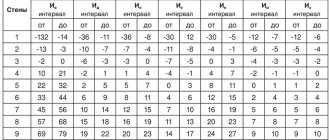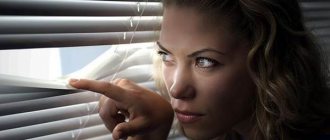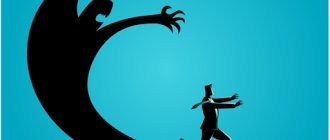Theoretical basis
Measuring anxiety as a personality property is especially important, since this property largely determines the subject’s behavior. A certain level of anxiety is a natural and obligatory feature of an active personality. Each person has their own optimal, or desired, level of anxiety - this is the so-called useful anxiety. A person’s assessment of his condition in this regard is for him an essential component of self-control and self-education.
Personal anxiety is understood as a stable individual characteristic that reflects a subject’s predisposition to anxiety and presupposes his tendency to perceive a fairly wide range of situations as threatening, responding to each of them with a specific reaction. As a predisposition, personal anxiety is activated by the perception of certain stimuli that are regarded by a person as dangerous to self-esteem and self-esteem. Situational or reactive anxiety as a condition is characterized by subjectively experienced emotions: tension, anxiety, concern, nervousness. This condition occurs as an emotional reaction to a stressful situation and can vary in intensity and dynamics over time.
Individuals classified as highly anxious tend to perceive a threat to their self-esteem and functioning in a wide range of situations and react with a very pronounced state of anxiety. If a psychological test expresses a high level of personal anxiety in a subject, then this gives reason to assume that he will develop a state of anxiety in a variety of situations, especially when they relate to the assessment of his competence and prestige.
Most of the known methods for measuring anxiety allow assessing only either personal anxiety, or state anxiety, or more specific reactions. The only technique that allows differentiated measurement of anxiety both as a personal property and as a state is the technique proposed by C. D. Spielberger. In Russian, his scale was adapted by Yu. L. Khanin.
Causes of anxiety by age
Anxiety can develop in a person at any age, including newborns. In infants, anxiety manifests itself in the form of excessive restlessness, frequent crying for no reason, disturbed sleep and poor appetite. But with age, the nervous system develops and becomes more complex, so signs of anxiety acquire more complex features.
Children's anxiety
Causes of high anxiety in preschool children include:
General condition of the child
Risk factors are: genetic predisposition to nervous disorders, personal characteristics, increased sensitivity (parental anxiety is transmitted to the child), birth injuries, previous infectious diseases and other pathological conditions during the newborn period. Also predisposing to increased anxiety in young children are diseases of the woman during pregnancy, ante-, intra- and postnatal lesions of the central nervous system of the newborn.
External factors
These include the family atmosphere and methods of raising a child. This may be excessive guardianship (when the child is the only one in the family, and he is deprived of independence and the right to choose) or, on the contrary, the absence of at least some care and attention, since the child is unwanted.
High anxiety in children often turns into neurosis (hysterical, neurasthenic, phobic and others).
School anxiety
The development of school anxiety is caused by:
- significant school loads;
- difficulties in overcoming the school curriculum;
- complete misunderstanding of individual school subjects;
- excessive demands from parents (our child must be the best or, conversely, our child is the most mediocre and lazy);
- negative attitude of school teachers towards the child;
- unsettled relationships with classmates, conflicts and quarrels;
- frequent changes of schools;
- frequent tests, tests and exams.
Increased anxiety in schoolchildren can develop into school neurosis (headache, digestive disorders on the eve of school), school phobia (fear of going to school), didactogenic neurosis (rejection of learning).
Teen Anxiety
The teenage period for a child is the most difficult and turning point. At this stage, the child undergoes not only hormonal changes, but also reconsiders his attitude towards himself and other people. The reasons for increased anxiety in teenagers are:
- complex hormonal changes that affect all organs and systems of the body, including the central nervous system;
- awareness of one’s own independence and right to choose, independent decision-making;
- changes occurring in the team (rejection of “black sheep”, aggression of peers, youthful maximalism);
- periodic activity, abruptly giving way to depression and apathy, sudden changes in mood.
Anxiety in adults
In adults, people are predisposed to increased anxiety by:
- certain life periods (male and female menopause, midlife crisis);
- specific professions associated with constant stress, overwork and long working hours (pilots, surgical doctors, emergency assistance to the population);
- difficulty communicating with new people or speaking in public;
- sexual problems;
- personal troubles (divorce, death of loved ones, illness, loss of job).
Processing the results
Processing the results includes the following steps:
- Determination of indicators of situational and personal anxiety using a key.
- Based on an assessment of the level of anxiety, making recommendations for correcting the subject’s behavior.
- Calculation of the group average indicator of situational anxiety (ST) and personal anxiety (PT) and their comparative analysis depending, for example, on the gender of the subjects.
Key
| ST | Answers | LT | Answers | ||||||
| №№ | 1 | 2 | 3 | 4 | №№ | 1 | 2 | 3 | 4 |
| Situational anxiety | Personality anxiety | ||||||||
| 1 | 4 | 3 | 2 | 1 | 21 | 4 | 3 | 2 | 1 |
| 2 | 4 | 3 | 2 | 1 | 22 | 1 | 2 | 3 | 4 |
| 3 | 1 | 2 | 3 | 4 | 23 | 1 | 2 | 3 | 4 |
| 4 | 1 | 2 | 3 | 4 | 24 | 1 | 2 | 3 | 4 |
| 5 | 4 | 3 | 2 | 1 | 25 | 1 | 2 | 3 | 4 |
| 6 | 1 | 2 | 3 | 4 | 26 | 4 | 3 | 2 | 1 |
| 7 | 1 | 2 | 3 | 4 | 27 | 4 | 3 | 2 | 1 |
| 8 | 4 | 3 | 2 | 1 | 28 | 1 | 2 | 3 | 4 |
| 9 | 1 | 2 | 3 | 4 | 29 | 1 | 2 | 3 | 4 |
| 10 | 4 | 3 | 2 | 1 | 30 | 4 | 3 | 2 | 1 |
| 11 | 4 | 3 | 2 | 1 | 31 | 1 | 2 | 3 | 4 |
| 12 | 1 | 2 | 3 | 4 | 32 | 1 | 2 | 3 | 4 |
| 13 | 1 | 2 | 3 | 4 | 33 | 1 | 2 | 3 | 4 |
| 14 | 1 | 2 | 3 | 4 | 34 | 1 | 2 | 3 | 4 |
| 15 | 4 | 3 | 2 | 1 | 35 | 1 | 2 | 3 | 4 |
| 16 | 4 | 3 | 2 | 1 | 36 | 4 | 3 | 2 | 1 |
| 17 | 1 | 2 | 3 | 4 | 37 | 1 | 2 | 3 | 4 |
| 18 | 1 | 2 | 3 | 4 | 38 | 1 | 2 | 3 | 4 |
| 19 | 4 | 3 | 2 | 1 | 39 | 4 | 3 | 2 | 1 |
| 20 | 4 | 3 | 2 | 1 | 40 | 1 | 2 | 3 | 4 |
Procedure
Instructions: “Read each of the sentences below carefully and cross out the number in the appropriate box on the right depending on how you feel at the moment. Don’t overthink the questions because there are no right or wrong answers.”
Spielberger Anxiety Scale: processing results
Processing the results includes the following steps:
- Determination of indicators of situational and personal anxiety using a key.
- Based on an assessment of the level of anxiety, making recommendations for correcting the subject’s behavior.
- Calculation of the group average indicator of situational anxiety (ST) and personal anxiety (PT) and their comparative analysis depending, for example, on the gender of the respondents.
Interpretation of STAI results
When analyzing the results of self-assessment, it must be borne in mind that the overall final score for each of the subscales can range from 20 to 80 points. The higher the final score, the higher the level of anxiety (situational or personal).
For a general interpretation of the indicators, the following indicative estimates of anxiety can be used:
- up to 30 points – low
- 31-44 points – moderate
- 45 or more – high
A comparison of the results on both subscales makes it possible to assess the individual significance of the stressful situation for the respondent.
Interpretation of results
When analyzing the results of self-assessment, it must be borne in mind that the overall final score for each of the subscales can range from 20 to 80 points. Moreover, the higher the final indicator, the higher the level of anxiety (situational or personal).
When interpreting the indicators, you can use the following indicative estimates of anxiety:
- up to 30 points – low,
- 31 - 44 points - moderate;
- 45 or more - high.
Individuals classified as highly anxious
, tend to perceive a threat to their self-esteem and functioning in a wide range of situations and react with a very pronounced state of anxiety. If a psychological test expresses a high level of personal anxiety in a subject, then this gives reason to assume that he will develop a state of anxiety in a variety of situations, especially when they relate to the assessment of his competence and prestige.
Individuals with high anxiety scores should develop a sense of confidence and success. They need to shift the emphasis from external demands, categoricalness, and high significance in setting tasks to meaningful comprehension of activities and specific planning for subtasks.
For those with low anxiety
people, on the contrary, need to awaken activity, emphasize the motivational components of activity, arouse interest, and highlight a sense of responsibility in solving certain problems.
State of reactive (situational) anxiety
occurs when you find yourself in a stressful situation and is characterized by subjective discomfort, tension, anxiety and vegetative arousal. Naturally, this state is characterized by instability over time and varying intensity depending on the strength of the impact of the stressful situation. Thus, the value of the final indicator for this subscale makes it possible to assess not only the level of current anxiety of the subject, but also to determine whether he is under the influence of a stressful situation and what is the intensity of this impact on him.
Personality anxiety
is a constitutional trait that determines the tendency to perceive threat in a wide range of situations. With high personal anxiety, each of these situations will have a stressful effect on the subject and cause severe anxiety in him. Very high personal anxiety directly correlates with the presence of neurotic conflict, with emotional and neurotic breakdowns and psychosomatic diseases.
A comparison of the results on both subscales makes it possible to assess the individual significance of the stressful situation for the subject. The Spielberger scale, due to its relative simplicity and effectiveness, is widely used in the clinic for various purposes: determining the severity of anxious experiences, assessing the state over time, etc.
High anxiety and its types
Diagnosis of the degree of anxiety is based on various psychological tests. Moderate and high anxiety affects the quality of life and can even lead to the development of mental disorders. It is believed that heredity is a predisposing factor for high anxiety. Another risk factor is inadequate upbringing and negative life experiences. Psychologists fight high anxiety, but on the condition that it is not a sign of mental illness.
Diagnosis of anxiety level
Diagnosing anxiety levels involves conducting various psychological tests and filling out questionnaires:
Questionnaire by Lavrentieva, Titarenko
Parents are asked to choose from 20 signs those that the child has:
- fatigue during work;
- difficulty concentrating;
- excessive anxiety when taking on a new task;
- tension and constraint when performing a task;
- frequent embarrassment;
- talking about tense situations;
- frequent facial hyperemia;
- complaints of scary dreams;
- coldness and wetness of hands;
- often upset stool;
- excessive sweating when excited;
- poor appetite;
- restless sleep, difficulty falling asleep;
- increased timidity, many fears;
- constant anxiety;
- inability to hold back tears;
- intolerance to waiting;
- fear of new things;
- lack of self-confidence;
- fear of difficulties.
The number of positive answers allows us to determine the level of anxiety: 15 - 20 points indicates high anxiety, 7 - 14 - average level of anxiety, and 1 - 6 points - a child with low anxiety.
Anxiety test according to Temple, Amen and Dorky
The child is asked to view some life situations indicated in the pictures in a certain sequence (14 pictures in total). He must respond with one emotion (joy or sadness) to each picture:
- you are playing with a small child, what kind of face do you have (sad or happy);
- you go for a walk with your mother and little brother (he is in a stroller);
- an elder is attacking you, what kind of face do you have;
- you dress yourself, whether you are happy or sad;
- you play with children older than you, you are happy or sad;
- you go to bed alone, and your parents are busy, you are happy or sad;
- you wash yourself, what kind of face do you have when you do it?
- your mother scolds you, you are sad or happy;
- parents play with the youngest, not paying attention to you;
- a peer wants to take away your toy, is it funny or sad;
- Mom made me pick up scattered toys, is it funny or sad;
- peers go home, you are happy or sad;
- you are with your whole family in the photo, are you sad or happy;
- you eat alone, is it sad or fun.
After viewing the pictures, a special table is filled out and the level of anxiety is calculated. In addition to facial expression, the child must accompany each drawing with his own comment. The level of anxiety is calculated using the formula: UT (anxiety) = (number of negative emotions / 14) * 100.
A VT of 50% and above indicates high anxiety, a VT equal to 20–50% indicates average anxiety, and a VT less than 20% indicates low anxiety.
Philips Anxiety Test
In school-age children, anxiety is determined according to Phillips. This is done by a school psychologist who tests a group of schoolchildren (class) at once. The Philips questionnaire consists of 58 questions, the answers to which allow you to assess:
- anxiety level of the entire class;
- the severity of feelings about stress in society;
- anxiety about possible successes and positive evaluations;
- fear about self-expression;
- fear about knowledge tests;
- fear about the opinions of classmates and teachers;
- level of resistance to stressful situations;
- fear about relationships with teachers.
Questions under certain numbers correspond to the criteria listed above. Each positive answer is counted as one point and summed up across groups, revealing the level of anxiety in a given group.
Spielberg-Hanin Anxiety Scale
Using this scale, the questionnaire of which consists of 40 questions, it is proposed to determine the level of anxiety independently. The first 20 questions assess situational anxiety, the second half of the questions assess personal anxiety.









